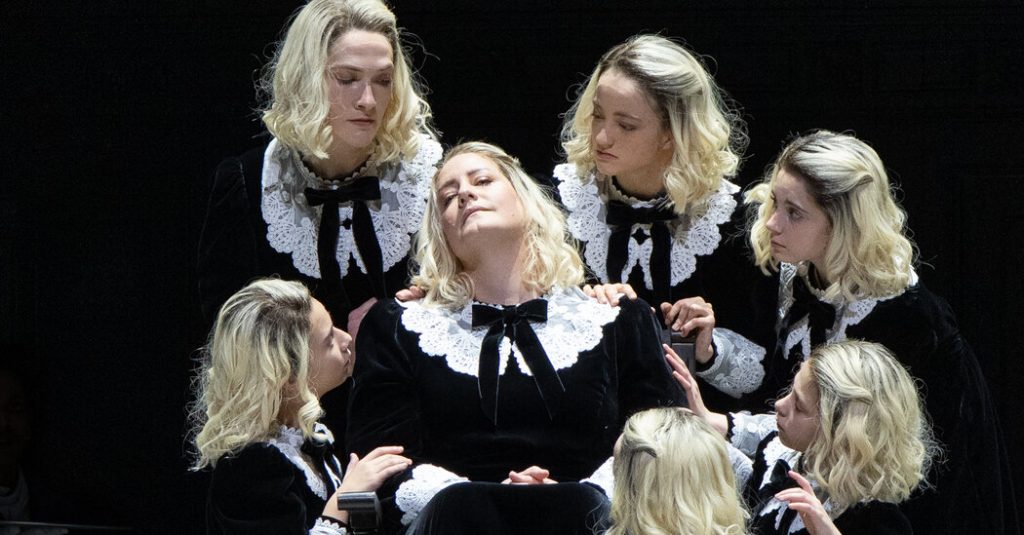“I’m ready,” Salome sings. And then she dances.
Her predatory stepfather has promised her anything she wants if she performs for him. She obliges with the alternately wild and delicate Dance of the Seven Veils, one of the most famous numbers in all opera.
A highlight of Strauss’s “Salome,” which the Metropolitan Opera will broadcast live to movie theaters on Saturday, it is also one of the art form’s greatest challenges. Few sopranos capable of singing the daunting role have much experience with dance, let alone with carrying a sensual nine-minute solo.
Is it a seduction? A striptease? A cry for help? Performers have taken this intense, lurid scene in many different directions, bringing out undercurrents of sexual awakening and violence. The Met’s new production inverts the traditional portrayal, uncovering the wounded girl beneath the stereotypical femme fatale.
Here are (yes) seven memorable versions from the long history of opera’s boldest dance.
Silent Salome
Not quite 20 years after the opera’s 1905 premiere, a silent film version of “Salome” — really an adaptation of the Oscar Wilde play on which the opera is based — embraced the material’s perfumed, verging-on-surreal Orientalism. The actress Alla Nazimova’s Salome is a spoiled, petulant teenager.
At first surrounded by handmaidens, this Salome dances barefoot in a white minidress as her clownish stepfather leers at her. Tiptoeing and twirling under a diaphanous veil, she is a dreamlike vision of fragile innocence — eventually coming into her own snarling power.
Involving veils makes it seem inevitable that Salome will at some point be unveiled. Strauss, though, said he wanted the scene to be “thoroughly decent, as though it were being done on a prayer mat.”
Ljuba Welitsch, the reigning Salome in the years after World War II, embraced undress — or at least the illusion of it — convincingly enough that George Petty, the renowned pinup artist, placed her first on his list of America’s “best undressed women.” But the statuesque Birgit Nilsson, who sang the part with rare force and clarity in the 1960s and ’70s, “wound up as fully dressed as she started,” according to a 1965 review in The New Yorker.
Naked Salome
At the other extreme from singers like Nilsson, some sopranos have ended the dance with a degree of nakedness. Few, though, have prolonged a disrobing more daringly than Maria Ewing, who in the Royal Opera’s production excerpted in this clip, stands, stark and unflinching, for some 25 seconds before collapsing to the ground.
By then, nudity had become far more prevalent in mainstream culture, including on opera stages. This was a long way from early Salomes — who tended to sit the scene out entirely, ceding it to a double — and even from Mary Garden, who achieved notoriety appearing in flesh-colored silk back when the opera was still a shocker, frequently subject to censors’ bans.
Part of the allure of the Dance of the Seven Veils over the past 120 years has been voyeuristic, sometimes fostered by the singers themselves. Grace Bumbry, ahead of an appearance at the Royal Opera at Covent Garden in 1970, promised that at the end of the dance she would be left in only “jewels and perfume.”
Actually, she got down to a kind of spangled bikini. “Covent Garden had never before rented so many opera glasses,” Bumbry said later, with a bit of braggadocio. “When I started dancing, everything else onstage stopped and I could see the glasses going up en masse.”
Dietrich-Style Salome
The Met’s last production, directed by Jürgen Flimm, premiered in 2004 during the Iraq War, and was set in the contemporary Middle East, with some Art Deco touches.
Those Deco elements included a throwback to Marlene Dietrich-style masculine-feminine costuming in the Dance of the Seven Veils. The dance began with Salome (played by the renowned stage animal Karita Mattila) dressed in a version of a man’s tuxedo jacket with tails, which she removed to reveal a black halter top. This bit of play with gender, the scene implied, was a key part of her strategy in seducing her stepfather.
Salome Under Attack
The Dance of the Seven Veils is, in its most literal form, Salome performing for her stepfather — and, by extension, for the audience. The emphasis is usually on how she uses her attractiveness as she seeks to manipulate others.
But this 2011 staging from Belgium focuses on a darker subtext: the way Salome has been shaped by the gaze and demands of others. Marguerite Borie’s production gives the dance some of the unsettling atmosphere of a gang rape, as Salome (June Anderson) is circled and pursued by a group of men. Part of her unveiling, in this case, is those men ripping off layers of her clothes. A recent staging by the small New York company Heartbeat Opera, too, flipped the mood from a jokey start into something far more ominous, as her stepfather and others surrounded and molested her.
Claus Guth’s new production at the Metropolitan Opera, which runs through May 24, is updated from the ancient world to a dour mansion at the turn of the 20th century. Starring Elza van den Heever as a capricious princess in a black frock with frills at the cuffs, the staging suggests that its title character is coming to terms with a dark past.
The seven veils have become a somberly formal, defiantly unsexy parade of seven versions of Salome, progressing from girlhood to adolescence and enacting, through a series of ballet lessons, a history of abuse at her stepfather’s hands.
It is the latest twist in a dance that keeps evolving.


